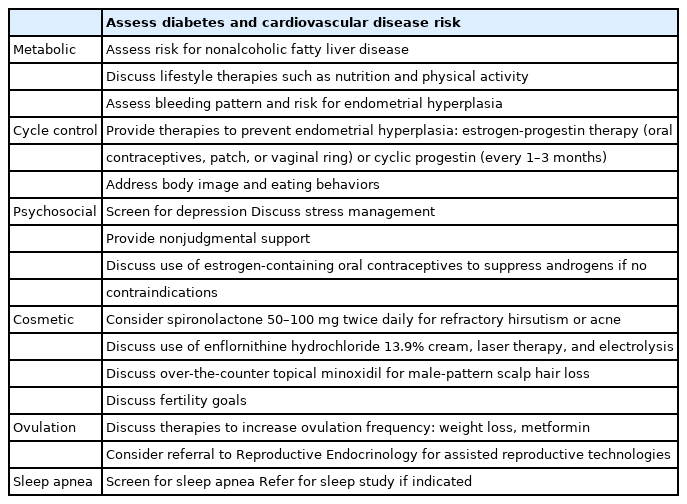Abstract
Polycystic ovary syndrome affects 6%-7% of reproductive-aged women, making it the most common endocrine disorder in this population. It is characterized by chronic anovulation and hyperandrogenism. Affected women may present with reproductive manifestations such as irregular menses or infertility, or cutaneous manifestations, including hirsutism, acne, or male-pattern hair loss. Over the past decade, several serious metabolic complications also have been associated with polycystic ovary syndrome including type 2 diabetes mellitus, metabolic syndrome, sleep apnea, and possibly cardiovascular disease and nonalcoholic fatty liver disease. In addition to treating symptoms by regulating menstrual cycles and improving hyperandrogenism, it is imperative that clinicians recognize and treat metabolic complications. Lifestyle therapies are first-line treatment in women with polycystic ovary syndrome, particularly if they are overweight. Pharmacological therapies are also available and should be tailored on an individual basis. This article reviews the diagnosis, clinical manifestations, metabolic complications, and treatment of the syndrome.
References
1. Setji TL, Brown AJ. Polycystic ovary syndrome: diagnosis and treatment. Am J Med 2007;120:128–32.
2. Rotterdam ESHRE/ASRM-Sponsored PCOS Consensus Workshop Group. Revised 2003 consensus on diagnostic criteria and longterm health risks related to polycystic ovary syndrome. Fertil Steril 2004;81:19–25.
3. Roe AH, Dokras A. The diagnosis of polycystic ovary syndrome in adolescents. Rev Obstet Gynecol 2011;4:45–51.
4. American Association of Clinical Endocrinologists Polycystic Ovary Syndrome Writing Committee. American Association of Clinical Endocrinologists Position Statement on Metabolic and Cardiovascular Consequences of Polycystic Ovary Syndrome. Endocr Pract 2005;11:126–34.
5. Badawy A, Elnashar A. Treatment options for polycystic ovary syndrome. Int J Womens Health 2011;3:25–35.
6. Lord JM, Flight IH, Norman RJ. Insulin-sensitising drugs (metformin, troglitazone, rosiglitazone, pioglitazone, D-chiro-inositol) for polycystic ovary syndrome. Cochrane Database Syst Rev 2003. CD003053.
7. Zimmermann S, Phillips RA, Dunaif A, Finegood DT, Wilkenfeld C, Ardeljan M, et al. Polycystic ovary syndrome: lack of hypertension despite profound insulin resistance. J Clin Endocrinol Metab 1992;75:508–13.
8. Azziz R, Carmina E, Dewailly D, Diamanti-Kandarakis E, Escobar-Morreale HF, Futterweit W, et al. The Androgen Excess and PCOS Society criteria for the polycystic ovary syndrome: the complete task force report. Fertil Steril 2009;91:456–88.



